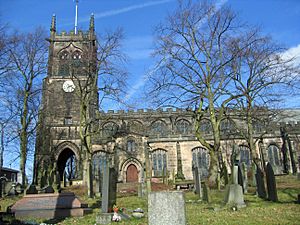St Mary's Church, Sandbach facts for kids
Quick facts for kids St Mary's Church, Sandbach |
|
|---|---|

St Mary's Church, Sandbach, from the south
|
|
| Lua error in Module:Location_map at line 420: attempt to index field 'wikibase' (a nil value). | |
| OS grid reference | SJ 759,608 |
| Location | Sandbach, Cheshire |
| Country | England |
| Denomination | Anglican |
| Churchmanship | Central |
| Website | St Mary's Church Sandbach |
| History | |
| Status | Parish church |
| Architecture | |
| Functional status | Active |
| Heritage designation | Grade II* |
| Designated | 11 August 1950 |
| Architect(s) | Sir George Gilbert Scott Austin and Paley |
| Architectural type | Church |
| Style | Gothic Revival |
| Completed | 1930 |
| Specifications | |
| Capacity | 400 |
| Materials | Red sandstone |
| Administration | |
| Parish | Sandbach |
| Deanery | Congleton |
| Archdeaconry | Macclesfield |
| Diocese | Chester |
| Province | York |
St Mary's Church is a beautiful old church located in Sandbach, a town in Cheshire, England. It's a very important building, listed as Grade II* on the National Heritage List for England. This means it's a special historic place. St Mary's is an active Anglican church, serving the local community.
Contents
History of St Mary's Church
There has been a church on this spot for a very long time. The Domesday Book, a famous survey from around 1086, mentions a priest and a church here. An old map from 1840 also shows the church in the center of Sandbach.
The church building you see today is mostly from the 1800s. The earlier church, built around the time of King Henry VII, was made of sandstone. This stone became very worn down over time.
From 1847 to 1849, a famous architect named George Gilbert Scott rebuilt much of the church. He replaced many parts and covered the old stone with new stone. The east end of the church was made longer by about 12 meters. The tower was also rebuilt to look like the old one. The stone for this work came from quarries near Mow Cop.
Later, in 1894–95, part of the west end needed repairs after a fire. In 1930, another architectural firm, Austin and Paley, added a choir vestry and a north porch. This cost £1,331. The church's records, called parish registers, go all the way back to 1562.
Church Architecture
Outside the Church
The church has a main area called a nave and a choir section. It also has aisles, which are like walkways on the sides, and side chapels. At the west end, there's a tall tower. A special thing about the tower is that it stands on three open arches. A public footpath actually goes right through these arches!
The church's style is mostly Perpendicular Gothic. This is a type of architecture from the late Middle Ages. You can still see some medieval stone in the church's arches.
Inside the Church
The baptismal font, used for baptisms, was made in 1859 from a type of stone called Caen stone. It has a special Greek inscription that reads "NIYON ANOMHMA MH MONAN OYINE". This means "Wash my sin not my countenance only." It's a clever phrase that reads the same forwards and backwards! An older font from 1669 was brought back to the church in 1938.
Around the walls of the aisles, you can see memorials. One is a marble carving dedicated to Rev. John Armistead, who was the vicar from 1828 to 1865. It was designed by George Frederic Watts. Another memorial is for John Ford, who passed away in 1839. It features a life-sized female figure.
The church roofs are quite old, dating back to 1661. The roof over the north aisle has a large coat of arms decoration. In the chapels and chancels, you can see beautiful stained glass windows. Some of these were made by William Wailes and others by Charles Eamer Kempe.
Church Bells
St Mary's Church has a set of eight bells. Four of these bells were made by Abraham II Rudhall in 1719. Another bell from 1782 is also thought to be by Thomas Rudhall. Three newer bells were made by John Warner and Sons in 1857, 1858, and 1868.
Outside the Church Grounds
The walls, gates, and railings around the churchyard are also considered historic. They are listed at Grade II. The churchyard is also a place of remembrance. It contains the war graves of fourteen service members. Eleven of these are from World War I and three are from World War II.
See also
- Grade II* listed buildings in Cheshire East
- Listed buildings in Sandbach
Images for kids
-
John Armitstead, Vicar of Sandbach 1828–1865 (1876 sculpture by George Frederic Watts inside St Mary's)




